Tricky Poses and Taxing Conditions: Performance and Media
-
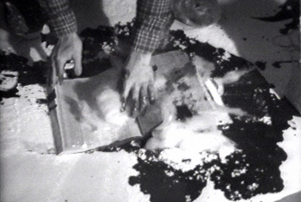 Ma Bell (1971) by Paul McCarthy
Ma Bell (1971) by Paul McCarthy
-
 Pulling Mouth (1969) by Bruce Nauman
Pulling Mouth (1969) by Bruce Nauman
-
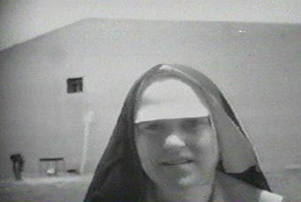 Nun and Deviant (1976) by Nancy Angelo & Candace Compton Pappas
Nun and Deviant (1976) by Nancy Angelo & Candace Compton Pappas
-
 A Glancing Blow (1979) by Richard Newton
A Glancing Blow (1979) by Richard Newton
-
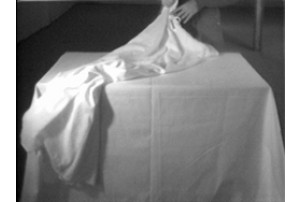 Frozen and Buried, by Cynthia Maughan
Frozen and Buried, by Cynthia Maughan
-
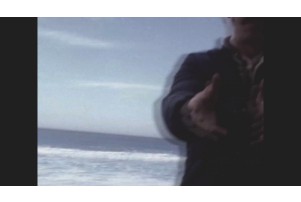 Trajectory, by Sam Erenberg
Trajectory, by Sam Erenberg
-
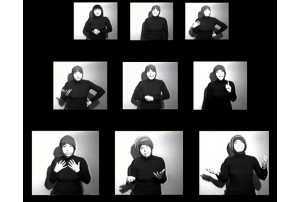 Big Tip, Back Up, Shout Out, by Susan Mogul
Big Tip, Back Up, Shout Out, by Susan Mogul
-
 Performance Under Working Conditions, by Allan Sekula
Performance Under Working Conditions, by Allan Sekula
February 19, 2012, 4:00PM
Spielberg Theatre at the Egyptian, 6712 Hollywood Blvd. Los Angeles CA 90028
Much early video work captured performance events in real time, utilizing this capability of video and its distribution. Some works went further, to analyze the nature of performance for media; replicating performances from past performances; and confronting the challenging space created by bodies. Less well known are films that also made these investigations. All films that have people in them in some way involve performance; these selections raise questions about the nature and purpose of performance, and also playfully look at how the camera, filmmaker, and projectionist also perform their roles.
Tickets: $10 general, $6 students/seniors; free for Filmforum members
Available on Brown Paper Tickets: http://www.brownpapertickets.com/event/224033
NOTE THE EARLY SHOW TIME!
Films to be Screened
-
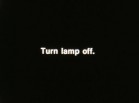 Projection Instructions by Morgan FIsher
Projection Instructions by Morgan FIsher
Projection Instructions (1976, 16mm, b/w, sound, 4min.)
Directed by Morgan FisherFrame in center.
Focus normally -
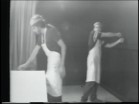 Performance Under Working Conditions, by Allan Sekula
Performance Under Working Conditions, by Allan Sekula
Performance Under Working Conditions (1973, video, b/w, 20min)
Directed byDirection: Allan Sekula; Camera: Lennart Bourin
Performance: Gregg Arreguin, Allan Sekula, David Scholar
Originally produced as a companion piece to a photo novel about working in a pizza restaurant, this early video performance is rarely shown, even though its title was lifted for a 2003 retrospective of Sekula’s work at the Generali Foundation in Vienna.
The structure is that of live television, an empty studio with two cameras and a switcher, no editing after the fact.
Two cooks try to reproduce the gestures and banter of their work minus the ingredients and utensils of the kitchen. This is labor performed as madcap talky pantomine, without capital. There’s a line here that goes back to the anarcho-syndicalism of Laurel and Hardy.
-
 Trajectory by Sam Erenberg
Trajectory by Sam Erenberg
Trajectory (1977, digital (orig. super 8), color, silent, 4:19)
Directed by Sam ErenbergTrajectory was made on a beach in Santa Barbara, CA. In Part I of the film, Erenberg and artist, Greg Card play catch with the camera, shot at distances from three to twenty feet. Part II begins with Card swinging the camera over his head. A 12' rubber cord was attached to the camera and swung overhead while being shot in semi-slow motion. There are two horizon lines: the ocean/sky and the top of the cliff/sky. The two lines are conflated while the camera turns in space. The manipulation of top-bottom, bottom-top creates a disorientated frame-space. - Sam Erenberg -
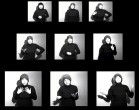 Big Tip, Back Up, Shout Out, by Susan Mogul
Big Tip, Back Up, Shout Out, by Susan Mogul
Big Tip/Back Up/Shout Out (1976, video, b/w, sound, 10:20)
Directed by Susan MogulFirst public screening since 1976!
“Her extroversion is so extreme that her story leaps from the vacuum around her, over the camera and off the screen entirely….I know of no way to reduce the fantastic density of Mogul’s chatter into a few lines of a review and still retain her hilarity - Artforum, December 1976 on Big Tip
-
 Ma Bell (1971) by Paul McCarthy
Ma Bell (1971) by Paul McCarthy
Ma Bell (1971, video, b/w, sound, 7min.)
Directed by Paul McCarthy“A black-and-white video of an early performance in which he takes on that maniacal/retarded persona of his. In this one, he creates a horribly visceral painting-sculpture by going through the phone book dumping motor oil from a bucket into the crease between the pages, then adding flour and cotton, then turning a bunch of pages until he gets all the way through the book and pressing down the stuff until the entire thing is like a morbidly obese sandwich of ooze. (As disgusting as it is, the thing has a strange, lardy Beuysian power even onscreen.)” – Jen Graves, at http://slog.thestranger.com/slog/archives/2009/09/04/paul-and-richard
-
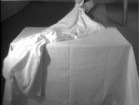 Frozen and Buried Alive, by Cynthia Maughan
Frozen and Buried Alive, by Cynthia Maughan
Frozen & Buried Alive (1974-75, video, b/w, sound, 1:30)
Directed by Cynthia MaughanThe maker recounts a past performance, almost too remarkable to be true. -
 Nun and Deviant (1976) by Nancy Angelo and Candace Compton Pappas
Nun and Deviant (1976) by Nancy Angelo and Candace Compton Pappas
Nun and Deviant (1976, video, b/w, sound, 20:28)
Directed by Nancy Angelo and Candace ComptonA classic example of feminist performance videos of the 1970s, which often incorporated autobiography, expansion of self through personae, and assertions of a new identity for women. In Nun and Deviant the performers come to happier terms with their identities both as women and as artists. As Angelo and Compton don and dismantle stereotypical guises before the camera/viewer, Nun and Deviant explores how repressive representations circulating in our culture are formulated as opposites such as Madonna-whore (nun-deviant)—cliches that force women to assume restrictive, paradoxical roles. – Video Data Bank
-
 A Glancing Blow (1979) by Richard Newton
A Glancing Blow (1979) by Richard Newton
A Glancing Blow (1979, digital (orig. super 8), color, sound, 8 min.)
Directed by Richard NewtonDirection: Richard Newton; Cameras: Charles C Hill, Stephen Seermayer; Music: Mona Lia Ventress, Nick Dodet
A Glancing Blow offers a new form of energy. Using sharp glancing blows, it demonstrates how we are now able to effect an energy transference from one American gas guzzler to another.
-
Cheap Imitations Part I: Méliès - India Rubber Head (1980, 16mm, b/w, sound, 5.5min.)
Directed by Grahame Weinbren and Roberta FriedmanAs a step in the argument of a paper about cinematic space, I referred to a film by Melies called India Rubber Head. The point of the example was to show that on film, there is no phenomenological difference between the enlargement of an object and its motion toward the viewer, a point the significance of which I have now mostly forgotten. Since I hadn't seen the film, I used a description of it by film scholar Christine Noll Brinckmann. The film sounded interesting, so we decided to make it according to the description and did so last December. When I showed it in Germany in February, an angry film scholar asked me if I realized that not only had the Melies film been misdescribed, but the remake didn't even follow this misdescription, and also, the original film was FUNNY. He went on to explain that the central issue in the remake, the decrease in size of the table as the head increased, was not in the original, which was made by double exposure of a head against a black velvet background. I asked him if he didn't think all these errors and lapses of memory didn't make the film better. He though not. Any way, I hope that the idea of flaws and disrememberings, mistaken descriptions and the impossibility of following instructions, are the issues of the piece.- Grahame Weinbren -
 I'm Too Sad To Tell You, by Bas Jan Ader
I'm Too Sad To Tell You, by Bas Jan Ader
I'm Too Sad To Tell You (1971, 16mm, b/w, silent, 3.5min)
Directed byCourtesy Patrick Painter Inc.
An extremely influential work, emulated by any number of artists after, and still retaining its spare beauty and sadness.
“In his later work, a degree of irony is still palpable through the use of kitschy, sentimental imagery, even as the act becomes increasingly difficult to discern as such. The series of films and photographs I’m too Sad to Tell You, 1970-71, document Ader crying for the camera. This trope of Hollywood melodrama, the teary close-up, becomes a rather convincing display of emotion. Here again, he isolates the action from any narrative context, which the Hollywood counterpart depends upon for effect.” – Brad Spence, “The Case of Bas Jan Ader,” basjanader.com